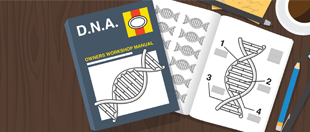What is a genome

The characteristics of all living organisms are determined by their genetic material and their interaction with the environment. An organism’s complete set of genetic material is called its genome which, in all plants, animals and microbes, is made of long molecules of DNA (deoxyribonucleic acid). The genome contains all the genetic information needed to build that organism and allow it to grow and develop.
Within the genome are regions of DNA called ‘genes’. These ‘genes’ can carry instructions for making proteins, which in turn give the organism its characteristics or ‘traits’. For example, the red colour of a pōhutukawa flower is determined by the plant’s genes, which carry the instructions for colour production within the flower. While every cell in an organism will have essentially the same genome, the differences between cells are determined by how and when different sets of genes are turned on or off. For example, genes in specialised cells in the eye are turned on to make proteins that detect light, while genes in red blood cells are turned on to make proteins for carrying oxygen.
Occasionally, changes to DNA in cells can occur that create a new and different version of a gene which can then be carried by that organism’s offspring. These changes are known as mutations and mean different individuals can carry different versions of that particular gene, which can result in differences in the trait within populations, for example for individual eye colour.
Identifying and using these different versions of genes, and the traits they create, has been an important part of agriculture for thousands of years. By cross-breeding plants with different versions of genes, and repeatedly selecting preferred plants from their offspring to serve as new parent lines, agricultural plants have been created over time with more desirable traits, such as higher yields, reduced toxicity, and improved flavour. Much the same is true of livestock animals.
View next section on history of genetic engineering to learn more.
